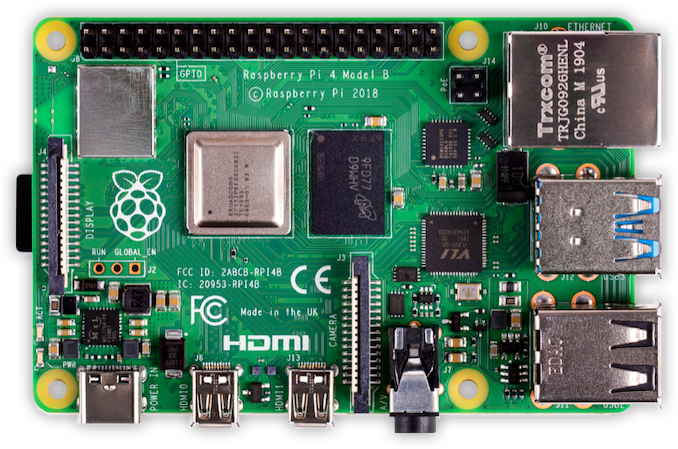Raspberry Pi 4 Launched: Quad Cortex-A72 Single-Board Computer For $35
by Ryan Smith on June 24, 2019 7:15 PM EST- Posted in
- Raspberry Pi
- Cortex A72
- Pi

This morning the Raspberry Pi Foundation took the wraps off of their next generation hobbyist project computer, the Raspberry Pi 4. The eagerly anticipated update to the Raspberry Pi lineup – which is actually arriving a bit ahead of schedule due to some good fortunes in SoC development – offers a significant upgrade to the family thanks to its new 28nm Broadcom SoC, which among other things incorporates a more powerful quad Arm Cortex-A72 CPU cluster. The single-board computer is available now, and like its predecessors, prices start at $35.
Long a favorite for tinkers, makers, and anyone else looking for a project board or a simple computer, the Raspberry Pi family has been around since 2012. Its last full update was in 2016, when the Foundation released the Raspberry Pi 3. In the intervening three years the technology landscape has changed a fair bit, and so has the underlying hardware of the Pi. While still based on Broadcom SoCs, the new Pi incorporates Broadcom’s BCM2711, a 28nm SoC with a quad Cortex-A72 setup along with the company’s VideoCore VI GPU. While the GPU remains nothing to write home about – the Raspberry Pi Foundation prioritizes an open GPU first and foremost – the CPU upgrade is far more interesting. This update replaces the old Cortex-A53 CPU cores with cores from Arm’s much faster high-performance line of out-of-order execution cores. As a result, even with a clockspeed of just 1.5GHz, the Pi 4 is a good deal faster than the Pi 3, not to mention faster than even some mid-range smartphones.
| Raspberry Pi | ||
| Raspberry Pi 4 | ||
| SoC | Broadcom BCM2711 4x Cortex-A72 @ 1.5GHz VideoCore VI @ 500Mhz |
|
| DRAM | 1/2/4GB LPDDR4 | |
| Storage | microSD | |
| Networking | 1x Gigabit Ethernet 802.11ac BT 5.0 |
|
| USB | 2x USB-A 3.0 2x USB-A 2.0 |
|
| Video Output | 2x HDMI 2.0 Type-D | |
| GPIO | 17 Pins | |
| Power | USB-C (Suggested: 15W, 5.1V/3A) | |
| Dimensions | 85.6mm x 56.5mm x 17mm | |
| Price | 1GB: $35 2GB: $45 4GB: $55 |
|
I/O has also received a much-needed upgrade for the latest Pi. The new SoC brings with it USB 3 support, giving the platform access to SuperSpeed USB data rates for the first time. HDMI support has been similarly bumped to 2.0 (meaning 4K output support), and fittingly, the board can now decode H.264 and H.265 video (another first) at resolutions up to 4K. Networking performance has been upgraded as well with the addition of a full-speed Gigabit Ethernet port, and joining the 802.11ac radio is support for Bluetooth 5.0.
All told, the Foundation is selling 3 different versions of the Raspberry Pi 4, depending on the memory configuration. The $35 model comes with 1GB of LPDDR4, while 2GB and 4GB models are available for $45 and $55 respectively. Which in the case of the latter two models is a significant shot in the arm for the board, as now they have two to four times the memory to play with.
Meanwhile, our sister site Tom’s Hardware already has an early review out, confirming much of what you’d expect from the Raspberry Pi 4 based on the specifications. CPU, memory, and storage performance are all greatly improved over past models, though power consumption has gone up a bit in the process.
Source: Raspberry Pi Foundation










65 Comments
View All Comments
slickcity - Tuesday, June 25, 2019 - link
Hack NASA?Sauce: https://thenextweb.com/security/2019/06/24/a-hacke...
koaschten - Tuesday, June 25, 2019 - link
https://pi-hole.net/ - best I did for my sanity while websurfing at home.beginner99 - Tuesday, June 25, 2019 - link
This one should be good enough for browsing and video watching instead of firing up the desktop (save power and AC costs).My dumb self bought a 3b+ just weeks ago, well I now know why it was very cheap. ;) I use it for Pihole which is a ad blocker on network (DNS) level. Any device in your home network will get ad blocking. IMHO especially helpful for mobile devices that don't have that many options for such browser plugins on mobile.
AthlonFever - Tuesday, June 25, 2019 - link
Hack into NASAlmcd - Monday, June 24, 2019 - link
Disappointing it launched without a way to store UEFI/bootloader onboard, but RPi seems to be "infallible" at this pointStormyParis - Monday, June 24, 2019 - link
There is a way to store a bootloader onboard: stick a micro-SD in it.Some people just whine, whine, whine.
voicequal - Monday, June 24, 2019 - link
Pi 4 has a 512KB EEPROM for boot code.https://www.raspberrypi.org/documentation/hardware...
lmcd - Tuesday, June 25, 2019 - link
I would've thought it'd be more prominently advertised, but this is great, thanks for posting!mode_13h - Monday, June 24, 2019 - link
Too bad the storage and GPU performance are still the worst in this class of device. Otherwise, there are some nice upgrades, in here.It'll be interesting to see how much it's hampered by thermal throttling.
nandnandnand - Monday, June 24, 2019 - link
Are you paying $35-55 for the "best in class" device?